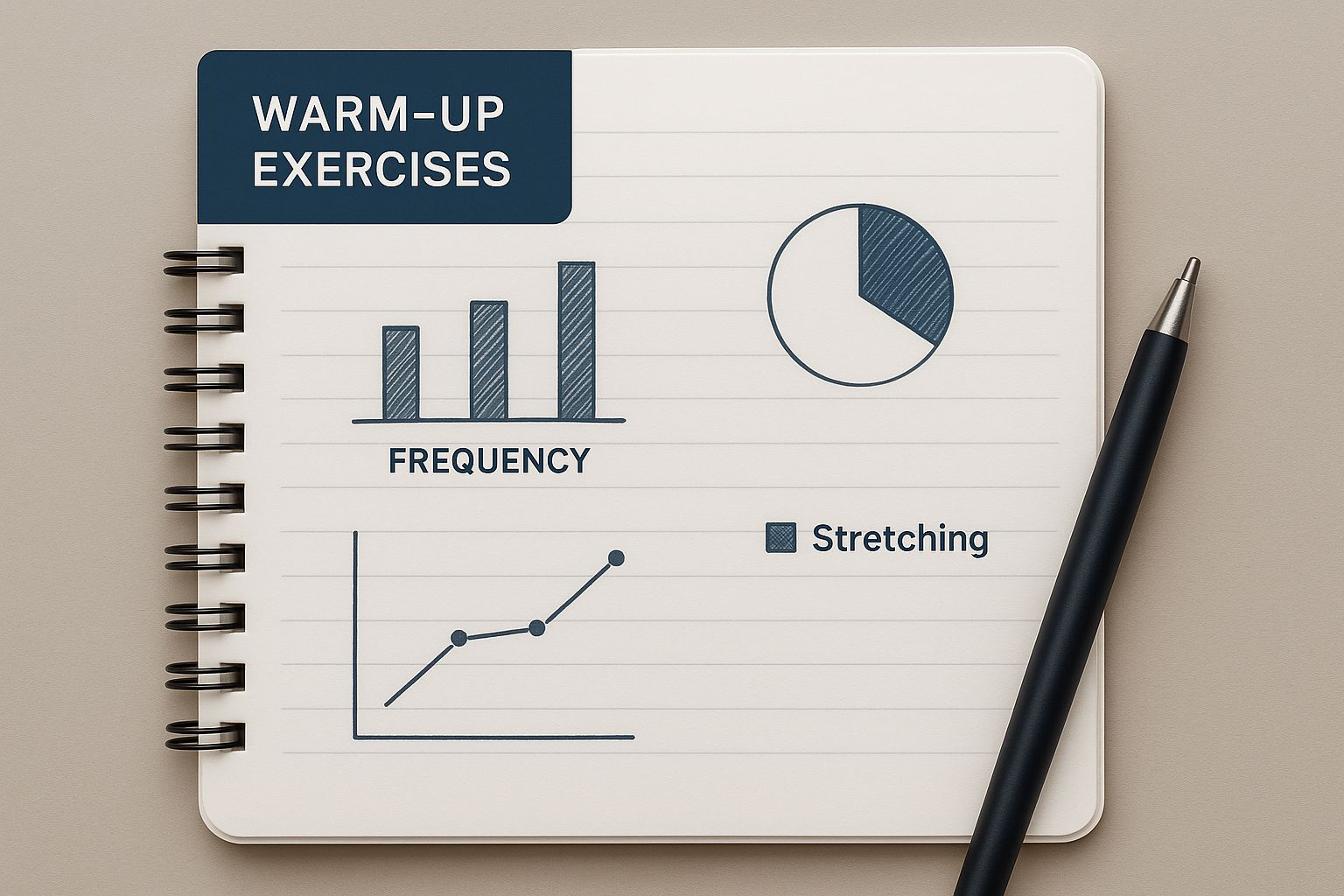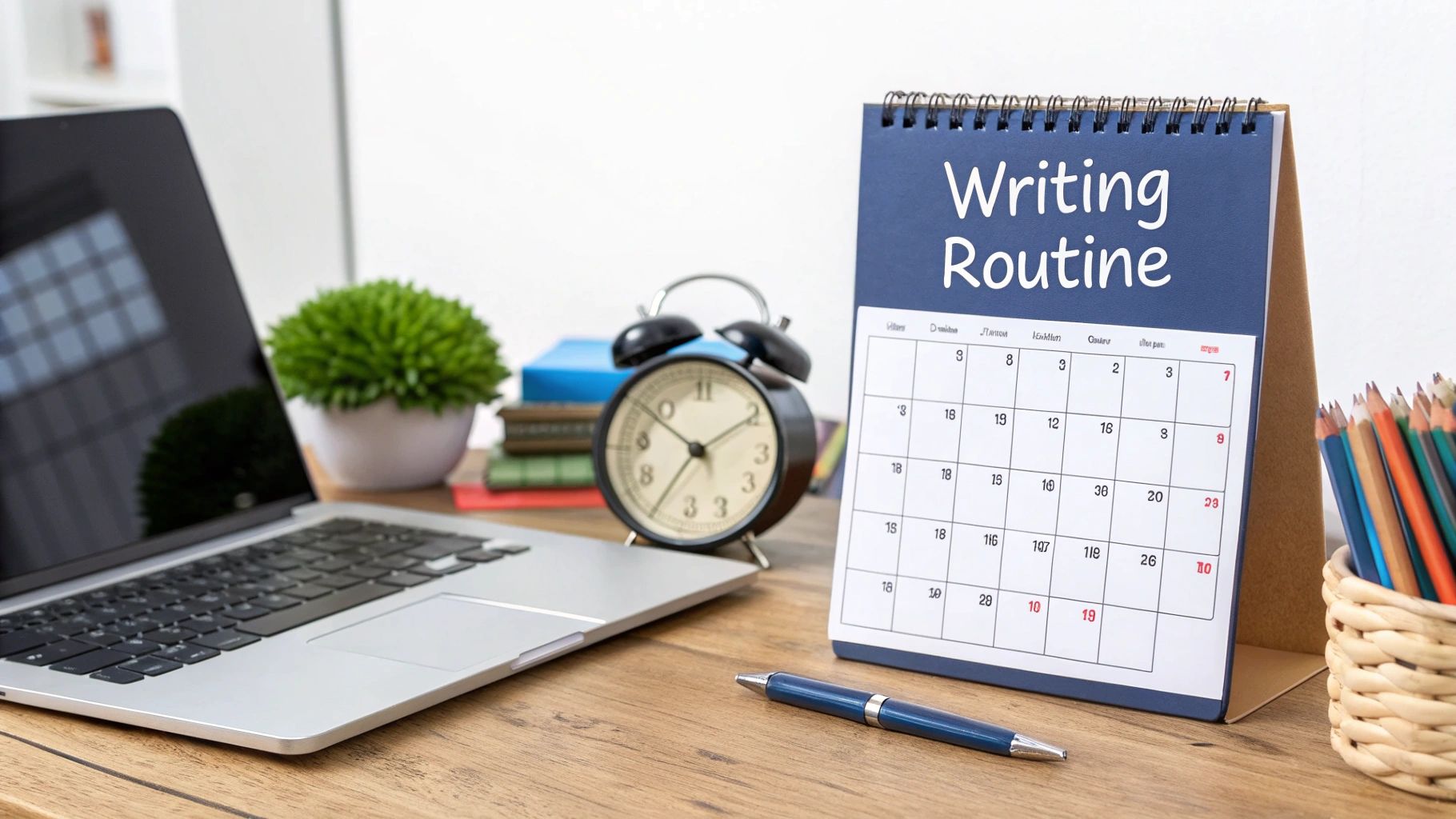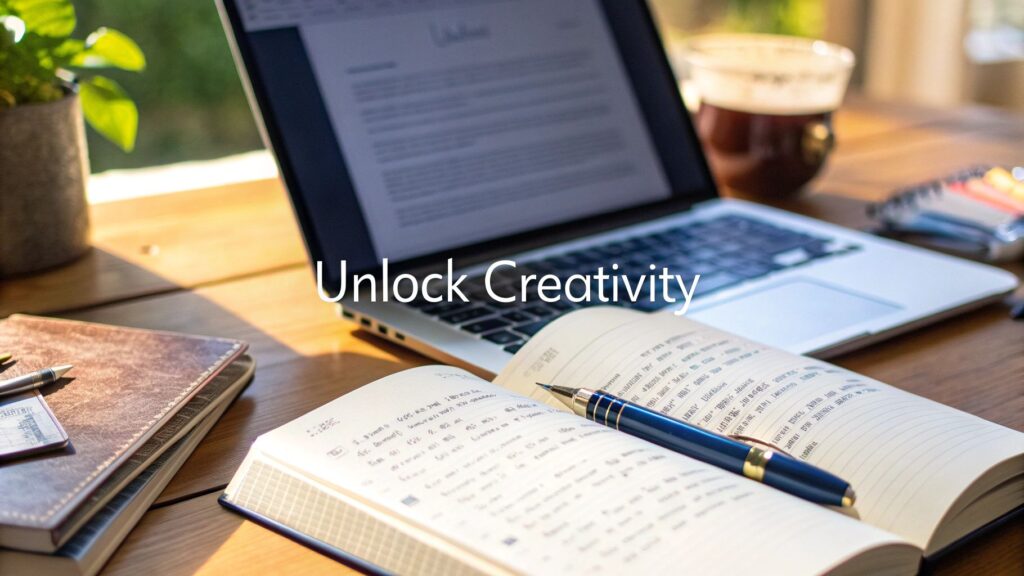Why Your Creative Mind Shuts Down When You Need It Most
We’ve all been there: staring at a blinking cursor on a blank page, the pressure mounting with every tick of the clock. It's not just a minor hiccup; it feels like your brain has hit the emergency brake. This frustrating paralysis isn't about a sudden lack of ideas. It’s a complex psychological response to the pressure and high expectations we place on ourselves, especially when a deadline looms or a project really matters.
The Real Culprits: Fear and Perfectionism
At the core of most creative shutdowns, you'll find fear and perfectionism working together. Think of perfectionism as fear in a clever disguise. It’s not really about having high standards; it’s the fear that your work won't measure up, that you'll face harsh judgment, or that you won’t meet your own impossibly high expectations. This inner critic tends to get loudest when the stakes are highest, creating a mental wall that makes even starting feel like an impossible task.
This often leads to procrastination, and if you dig into the psychology of procrastination, you’ll see how closely these issues are linked. Trying to just "push through" can backfire, because it only adds to the pressure that caused the block in the first place. It’s not a question of willpower.
The Psychological Toll of the Blank Page
This struggle is a deeply human experience, not some rare affliction. When writing is tied to your identity or how you make a living, the mental weight can feel immense. Research confirms a strong connection between writing struggles and mental well-being, revealing that a staggering 80% of writers have reported dealing with an affective disorder at some point.
Understanding this link is crucial. It allows you to approach writer's block with self-compassion instead of beating yourself up. You can learn more by exploring the full research on writer well-being. Recognizing these psychological patterns is the first real step toward breaking them down and getting back to your creative flow.
The Hidden Cost of Creative Blocks on Writers Everywhere

That sinking feeling of being creatively stuck isn't just a personal failure; it's a universal experience that connects writers across the globe. The frustration of staring at a blinking cursor is more than just a missed deadline. It erodes your confidence, affects your mental health, and can even make you question your identity. For many of us, writing isn't just a job or a hobby—it's a core part of who we are. When the words won't come, it can feel like a part of you has gone silent.
More Than Just a Bad Writing Day
The ripple effects of a creative drought can be surprisingly deep. Picture a novelist who, after a successful debut, finds themselves completely unable to start their second book. The block isn't just about a lack of productivity; it's about a stalled career and mounting financial pressure. Or consider a blogger whose once-consistent output slows to a trickle, causing their audience engagement and income to plummet. These aren't made-up scenarios; they happen every day to writers of all kinds.
This struggle knows no borders. While it's tough to find exact global statistics, the impact is undeniable. Writers on every continent face creative dry spells that can stretch from weeks into months or even years. Understanding that you're not alone in this is a crucial first step toward overcoming writer’s block. You can read more personal stories about the universal misery of this creative struggle on davidjrogersftw.com.
The Emotional and Professional Fallout
The true cost of writer's block isn't measured in word count. It's seen in abandoned projects, strained professional relationships, and the quiet grief for a passion that now feels like a chore. Some writers end up walking away from their craft for good, convinced their creative well has run dry. But many others find a way through, often emerging with a more resilient and stronger voice.
Acknowledging the full scope of the problem—its effect on your well-being, career, and sense of self—is often the first real breakthrough. It’s the moment you stop blaming yourself and start looking for a way back to the page.
Battle-Tested Techniques From Writers Who've Been There
When you're staring at a blank page, hearing "just write" can be more frustrating than helpful. Let's skip the generic advice and get into some real, practical strategies from writers who have actually been in the trenches, fought the block, and won. These aren't just theories; they're field-tested methods to get you moving when nothing else seems to work.
Embrace the Terrible First Draft
Perfectionism is often the villain in the story of writer's block. The pressure to write something brilliant right out of the gate can freeze you in your tracks. The most powerful thing you can do is give yourself permission to write something absolutely, unapologetically awful.
The goal isn't to create a masterpiece; it's to build momentum. Tell yourself, "This is just a messy brain dump for my eyes only." You'll be amazed at how liberating it feels to muzzle that inner critic. You can't edit a blank page, but you can always polish a messy one. This mindset is a cornerstone of any effective book writing process.
Change Your Tools and Environment
Sometimes the block isn't coming from inside your head, but from the rut of your routine. If you're always glued to your keyboard, try picking up a pen and writing in a notebook. If your desk feels like a prison, grab that notebook and head to a park or a bustling coffee shop.
Even small shifts can break the mental logjam. For instance, if the physical act of typing feels like a chore, try speaking your thoughts instead. Using specialized dictation software tailored for writers can be a game-changer, removing the friction between your ideas and the page, and letting your thoughts flow more naturally.
This infographic breaks down a few simple warm-up exercises you can do before diving into your main writing session.

The main idea is that spending just 5-10 minutes on a low-pressure activity like freewriting or brainstorming can get your creative engine warmed up. These exercises aren't about producing perfect prose; they're about getting the words flowing, no matter how they come out.
Dismantling Fear and Perfectionism From the Inside Out

Let's get real for a second: most creative blocks aren't about a lack of ideas. They're about being terrified of not being good enough. This is where fear puts on a clever costume, calling itself "maintaining high standards," and traps you in a loop of self-doubt and staring at a blank page.
The pressure to write a perfect first draft is a classic creativity killer. It can freeze you completely. Over time, you might even start measuring your self-worth by your daily word count—a recipe for burnout. The psychological weight of a creative slowdown is massive, and it often comes down to this need to get everything right the first time. You can dig deeper into overcoming these psychological hurdles at janefriedman.com. The first step to breaking free is to separate the act of writing from the act of editing.
Reframing Your Inner Critic
Instead of trying to banish your inner critic, think of it as a very eager editor who just showed up at the wrong time. Its feedback is valuable, but only after the initial, messy, creative part is done. When that critical voice starts whispering (or shouting) during a first draft, just acknowledge it and say, "Thanks, I'll deal with you during revisions." This simple mental shift can be surprisingly effective.
A huge part of tearing down these internal walls involves specific strategies for overcoming self-doubt. True confidence isn't about never feeling doubt; it's about learning how to manage it. Here are a few practical ways to get started:
- Set a “Messy First Draft” Quota: Give yourself a word count goal where the only rule is that quality doesn't matter. Just get the words down.
- Create a “Praise File”: Keep a document or folder with positive feedback you’ve received on your work. Open it up when self-doubt starts to creep in.
- Focus on the Process, Not the Product: Pat yourself on the back for sitting down to write, regardless of the outcome. This helps detach your sense of accomplishment from the final product.
This approach turns imperfection from an enemy into a necessary and even welcome part of the creative process. As you build these healthier habits, you might find that certain software can help. We’ve put together a list of useful writing tools for authors that can support you as you find a better workflow.
Creating Your Personal Block-Prevention Framework
The best way to beat writer's block is to stop it before it even starts. Instead of frantically searching for a fix when the words won't come, you can build a personal system that keeps your creative well from running dry. This isn't about following a strict, punishing schedule. It's about creating a flexible framework that works with your life, your energy, and your unique creative rhythm.
Design a Routine That Serves You
The word "routine" can sometimes sound boring or restrictive, but the real goal here is to eliminate the friction that stops you from writing. A good routine makes starting easier by taking the guesswork out of it. Your perfect routine might not look like waking up at 5 a.m. to write. Maybe it’s carving out two solid hours on a Tuesday afternoon or using your lunch break just for brainstorming. The secret is consistency over intensity.
A few ideas to get you started:
- Time Blocking: Open your calendar and schedule specific, non-negotiable appointments with your writing. Even a 30-minute block is a win.
- Energy Matching: Are you a morning person or a night owl? Schedule demanding creative tasks like drafting new scenes for your high-energy periods. Save mechanical tasks like editing or research for times when your brain is a little more tired.
- Pre-Writing Rituals: Create a small ritual to signal that it's time to write. This could be as simple as brewing a specific cup of tea, putting on a particular playlist, or doing a five-minute meditation. These cues train your brain to shift into creative mode on command.
To really get ahead of writer's block, it's helpful to build a full toolkit of prevention strategies. Think of it as a personalized system with daily, weekly, and monthly practices to keep you on track.
| Prevention Area | Daily Practice | Weekly Check-in | Monthly Review | Warning Signs |
|---|---|---|---|---|
| Creative Input | Read, watch, or listen to something unrelated to your project for 30 minutes. | Visit a new place (cafe, park, museum) to get fresh inspiration. | Read a book or watch a film completely outside your usual genre. | Feeling uninspired; ideas feel stale or repetitive. |
| Mental Well-being | Practice 5-10 minutes of mindfulness or journaling. | Disconnect from all screens for a few hours. | Assess your work-life balance and adjust your schedule accordingly. | Increased anxiety about writing; frequent procrastination. |
| Physical Health | Go for a short walk or do some stretching. | Ensure you're getting enough quality sleep. | Evaluate your diet and exercise habits for energy levels. | Physical fatigue; headaches when trying to write. |
| Project Momentum | Write just one sentence or 50 words to maintain the habit. | Review your progress for the week and set a small goal for the next. | Re-read your project outline and reconnect with your "why." | The project feels overwhelming; you avoid opening the document. |
This table is a starting point—your own toolkit might look different. The key is to be intentional about nurturing your creativity so you aren't just reacting to problems as they appear.
Curate Your Creative Environment
Your writing space has a bigger effect on your creativity than you might think. A messy desk, constant interruptions, or an uncomfortable chair can create just enough mental static to make writing feel like an impossible task. Take a look around your workspace. What helps you focus? What distracts you?
This could be as simple as decluttering your desk at the end of each day or finding the perfect ambient sound app. For some, investing in a pair of noise-canceling headphones is a game-changer. For others, it’s about finding a spot with good natural light. You're setting the stage for success.
For authors who are managing the entire process from first draft to publication, having a structured plan is vital. As you develop your prevention habits, it helps to see how they fit into the bigger picture. You can get a clear overview of the entire journey with a self-publishing checklist. This helps you connect your daily writing efforts to your long-term goals, making the whole process feel more manageable and meaningful.
Transforming Blocks Into Creative Breakthroughs
What if that blinking cursor on a blank page isn't a sign you’ve failed, but an invitation to try something new? It’s a tough concept to embrace, especially when the frustration is mounting, but changing how you see writer's block is the key to finally moving past it. Instead of treating it like an enemy, think of it as a signal from your creative mind that it’s ready for a change—maybe a new genre, a more authentic voice, or a deeper look at your topic.
This isn't a new problem. A quick look at the history of writer's block shows that authors have been wrestling with this for ages. But our approach to it can be new. When you see it as a natural part of the creative cycle instead of a personal failing, you open yourself up to fresh possibilities.
Mining the Block for Material
Your struggle itself is packed with creative fuel. The frustration, the doubt, the feeling of being completely stuck—these are universal human experiences. Many seasoned writers use these difficult periods to inspire their most powerful work. That novel you've stalled on might be telling you to dig deeper into a character's internal conflict. That blog post that feels flat might need a more personal, vulnerable story to connect with readers.
Here’s how you can turn that frustration into progress:
- Journal About the Block: Get honest about how it feels. Don't hold back or censor yourself. This practice can often uncover the hidden fears or pressures that are causing the paralysis in the first place.
- Take a Strategic Break: Step away from the project completely. This isn't the same as quitting; it's giving your subconscious the space it needs to work. As Ernest Hemingway famously advised, stopping when you know what happens next allows your mind to solve creative problems in the background.
- Experiment with a New Form: If your novel is going nowhere, try writing a short poem from your protagonist's point of view. If your article feels stale, turn the central idea into a fictional dialogue between two characters.
This simple shift in perspective can turn a frustrating roadblock into a detour that leads you somewhere far more interesting. It’s not about forcing the words out. It’s about listening to what their absence is trying to tell you.
At BarkerBooks, our team helps authors navigate every stage of their writing journey, including those tough moments of creative doubt. We can offer the editorial guidance and support you need to turn your creative challenges into your biggest breakthroughs.
